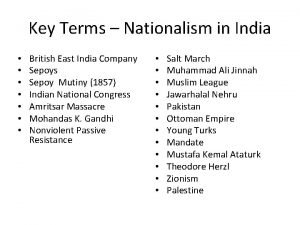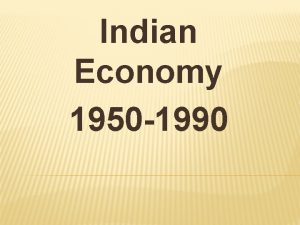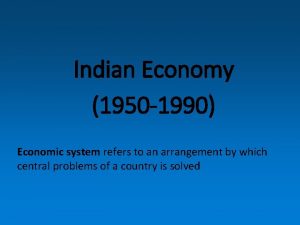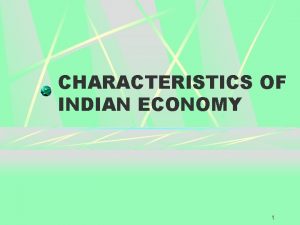CHAPTER II INDIAN ECONOMY 1950 1990 India woke



















- Slides: 19

CHAPTER II INDIAN ECONOMY 1950 – 1990

India woke to a new dawn of freedom on 15 August 1947. Among the three economic systems, India adopted Mixed economy, where all good features of capitalism and socialism can be seen. Here the market forces and government together decide things.

FIVE YEAR PLANS - LONG TERM GOALS

1. Growth : It refers to an increase in the capacity of the country to produce goods and services. 2. Modernization : Adoption of new technology to produce various goods and services 3. Self-reliance : It refers to use of our own resources for our development 4. Equity : It means the getting of the benefits of economic prosperity to the poor.

The National Planning Commission was established in 1950. Prime minister is the chair person of NPC. It has also a Deputy Chair person ( now it is Montegue Singh Aluwaliah). Planning started in India in 1951. P. C. Mahalanobis is regarded as the architect of Indian planning.


Narendra Modi- present chairman - NPC

Dr. Montagu Singh Aluwaliah- present Deputy Chairman NPC

INDIAN ECONOMY- AFTER INDEPENDENCE

AGRICULTURE. 1. Green Revolution & 2. Land reforms

LAND REFORMS It means change in the ownership of land holdings. The main features of this reforms were (a) Abolition of intermediaries – so that 200 lakh tenants came in to direct contact with the government. (b) The tillers were made the actual owners of the land ( c) Fixing of land ceiling - fixing the maximum size of the land a person can own. It reduced the concentration of land in the hands of a few.

The main drawbacks of the reforms (a) The poorest of the agricultural labors did not benefit from land reforms. (b) The big land lords challenged the legislation in courts, which delayed implementation. ( c) The loop holes in the legislations were exploited by the big land lords. (d) The land reforms were successful in the states of Bengal and Kerala only.

Green Revolution Green revolution refers to a large increase in the production of food grains resulting from the use of High Yielding Variety of Seeds, fertilizer, pesticides and irrigation.


The main advantages of Green revolution are (a) It enabled India to attain self sufficiency in food grains. (b) The dependence on foreign countries for food grains declined. (c ) Rapid growth of agricultural output. (d) Increased the market surplus- The portion of the agricultural product sold in the market at a price by the farmers is called market surplus. (e) The price of the food grains decreased compared to other goods. It benefited the poor. (f) It helped the government to procure sufficient food for future usage.

INDUSTRY The main features of industry after independence is the Industrial Policy Resolution 1956.

The main features of IPR are (a) It classified industries in to three- Public sector industries, private sector industries and with both private and public. (b) No new industries were allowed without a license from government. (c ) The industries established in backward regions were given tax benefits, electricity at low rates etc which promoted regional equality.

A small scale industry is defined as an industrial unit with a maximum investment of rupees one crore. Importance of small scale industries They are more labor intensive. They create more employment opportunities. But they can’t compete with the big ones. Measures for the promotion of small scale industries 1. Products should be reserved for them. 2. The government provided concessions like lower excise duty, loans at low interest rate etc. 3. Low electricity tariff etc.

TRADE The policy regarding trade during the first seven plans were “inward looking” or “import substitution”. This policy aimed at the replacement of imports with domestic production. The protection from imports can be done in two ways – tariffs and quotas. Tariffs are the tax imposed on imports. It make imports more expensive. On the other hand quotas specify the quantity of goods which cab be imported. The policy of protection was based on the idea that, the domestic industries of the developing countries are not able to compete with that of developed countries,
 Chapter 15 india and the indian ocean basin notes
Chapter 15 india and the indian ocean basin notes Chapter 15 india and the indian ocean basin
Chapter 15 india and the indian ocean basin If with past perfect and would be able/would have been able
If with past perfect and would be able/would have been able Past participle rest
Past participle rest Chapter 10 hunger games questions
Chapter 10 hunger games questions Woke present tense
Woke present tense Beatrice woke from her aptitude
Beatrice woke from her aptitude Athens vs sparta differences
Athens vs sparta differences Nationalism
Nationalism Indian soldiers hired by the british east india company
Indian soldiers hired by the british east india company Eviss takip sistemi
Eviss takip sistemi Jika cos a=0 6 dan a sudut lancip maka nilai cot a
Jika cos a=0 6 dan a sudut lancip maka nilai cot a Trauma from occlusion sequence
Trauma from occlusion sequence 1950 luvun kirjallisuus
1950 luvun kirjallisuus Autumn rhythm (number 30) 1950
Autumn rhythm (number 30) 1950 Popkunsten
Popkunsten Pop art 1950 60
Pop art 1950 60 Lbb 1950/10
Lbb 1950/10 Modernist poetry
Modernist poetry Famous italian fashion houses
Famous italian fashion houses





































